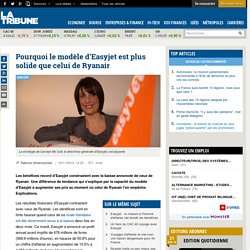

Pourquoi le modèle d’Easyjet est plus solide que celui de Ryanair. Les résultats financiers d'Easyjet contrastent avec ceux de Ryanair.

Les bénéfices sont en forte hausse quand ceux de sa rivale irlandaise ont été récemment revus à la baisse deux fois en deux mois. Ce mardi, Easyjet a annoncé un profit annuel avant impôts de 478 millions de livres (569,9 millions d'euros), en hausse de 50,9% pour un chiffre d'affaires en augmentation de 10,5% à 4,258 milliards de livres. Un record pour la low-cost britannique, qui a décidé de reverser 308 millions de livres de dividendes à ses actionnaires, déjà tout sourire d'avoir vu l'action de la compagnie bondir de 69% depuis le début de l'année, après avoir déjà augmenté de 79% en 2012. Une performance boursière qui fait pâlir les actionnaires de Ryanair. Le 4 novembre, son directeur général, Michael O'Leary, prévoyait une baisse de son bénéfice net à l'issue de son exercice fiscal, fin mars, compris entre 500 et 520 millions d'euros. Une question de recettes Les courbes des compagnies se croisent. Ryanair seeks increased profits through Easyjet's business model.
RYANAIR has paid tribute to arch rival EasyJet in a bid to see an upturn in profit prospects.

The airline has this week announced full-year profits of £426million. This is down from £465million a year earlier – something it has blamed on intense competition and falling fares. But the airline says it still expects to see a boost in revenue from the summer market and has also taken several measures to remedy the loss. Deputy chief executive Howard Millar has revealed that the company examined EasyJet’s business model, taking into account its operating strategies as well as its less aggressive image. While O’Leary admitted: “To be fair, some of the things EasyJet has done, like allocated seating, have been very effective. Qantas Airways Company SWOT Analysis Report. SWOT ANALYSIS of Qantas Airways Australia Qantas is an Australian airline group.

The group's strong dominance in Australian domestic market enables it to take advantage of the local expertise to gain access to key markets as well as enhance the quality of its delivery services. However, increased competition from the growing number of low cost and low fare airlines could impact the group's market share especially in the Asian region. Strengths Strong dominance in Australian domestic market The multi brand strategy allowed the group to position Qantas’ domestic network as ‘best for business and premium travel’ supported by Jetstar offering consistently low fares. Diversified geographic markets The group’s offers transportation services across geographies by using its two complementary airlines, Qantas and Jetstar which operates international, domestic and regional services. Jetstar’s main markets are domestic and international traffic to and from Australia. Weaknesses. Jetstar - SWOT analysis. Strength, Weaknesses, Opportunities, Threats for over 40,000+ companies and industries.
Flag carrier. Low cost airlines. Transavia: too little, too late? Air France-KLM’s LCC enjoys a growth spurt. At the time of Air France-KLM’s 2Q2013 results on 26-Jul-2013, Group chairman and CEO Alexandre de Juniac said that the turnaround of the medium-haul business was taking longer than expected.

“Further measures” are to be adopted, including “industrial and commercial decisions” and more job losses. Although he did not give details of these measures, it seems likely that they will include an acceleration of the growth of Transavia, the group’s LCC, to become its principal short/medium-haul point-to-point operator. In this report, we analyse Transavia’s network and market position and compare its unit costs both with its parent and with the other European LCCs that have been so damaging to Air France-KLM. The Dutch arm of Transavia has been part of KLM for more than 20 years and the French operation started up in 2007, but the group has not fully exploited its potential. Air France-KLM’s LCC based in Amsterdam and Paris Number two airline at Amsterdam, number four at Orly Superior load factor.